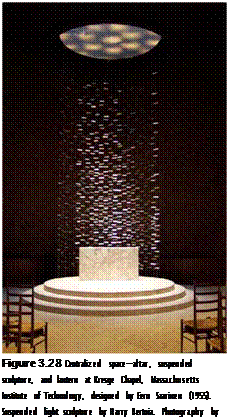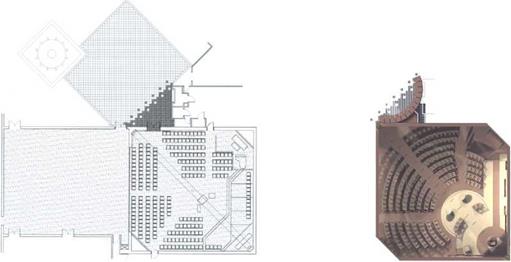 Centralized spatial order draws focus toward the center of a space. The interior of Eero Saarinen’s chapel at the Massachusetts Institute of Technology relies on three elements to draw the visitor’s focus toward the center of the space: a built-in marble altar, a circular light lantern located in the chapel’s ceiling, and a full-height metal sculpture by Harry Bertoia centered above the altar and suspended below the lantern (Figure 3.28). The size, location, orientation, and surface articulation of these three components, in concert with the dynamic effect of changing daylight brought into the chapel through the lantern above reinforce the chapel’s centralized spatial typology.
Centralized spatial order draws focus toward the center of a space. The interior of Eero Saarinen’s chapel at the Massachusetts Institute of Technology relies on three elements to draw the visitor’s focus toward the center of the space: a built-in marble altar, a circular light lantern located in the chapel’s ceiling, and a full-height metal sculpture by Harry Bertoia centered above the altar and suspended below the lantern (Figure 3.28). The size, location, orientation, and surface articulation of these three components, in concert with the dynamic effect of changing daylight brought into the chapel through the lantern above reinforce the chapel’s centralized spatial typology.
A centralized space (or any specific spatial typology) is an experiential phenomenon that is influenced by many factors. Furniture, material, people, activity, acoustics, and lighting are variables that influence the perception of space. The existing centrality of the chapel shown in Figure 3.29 was made more pronounced in the renovation through the transformation of material, lighting, acoustics, and new furniture.
|

![]()



